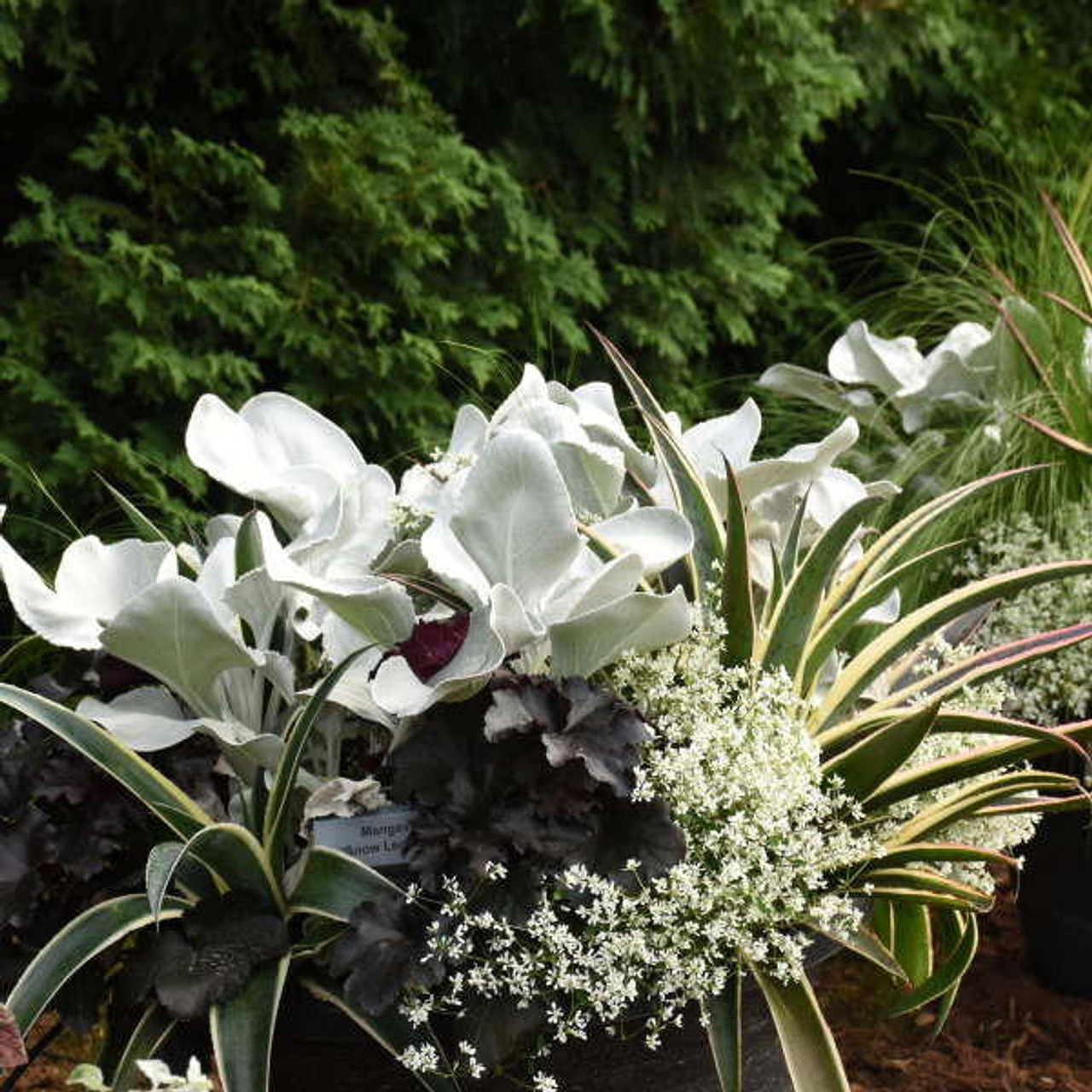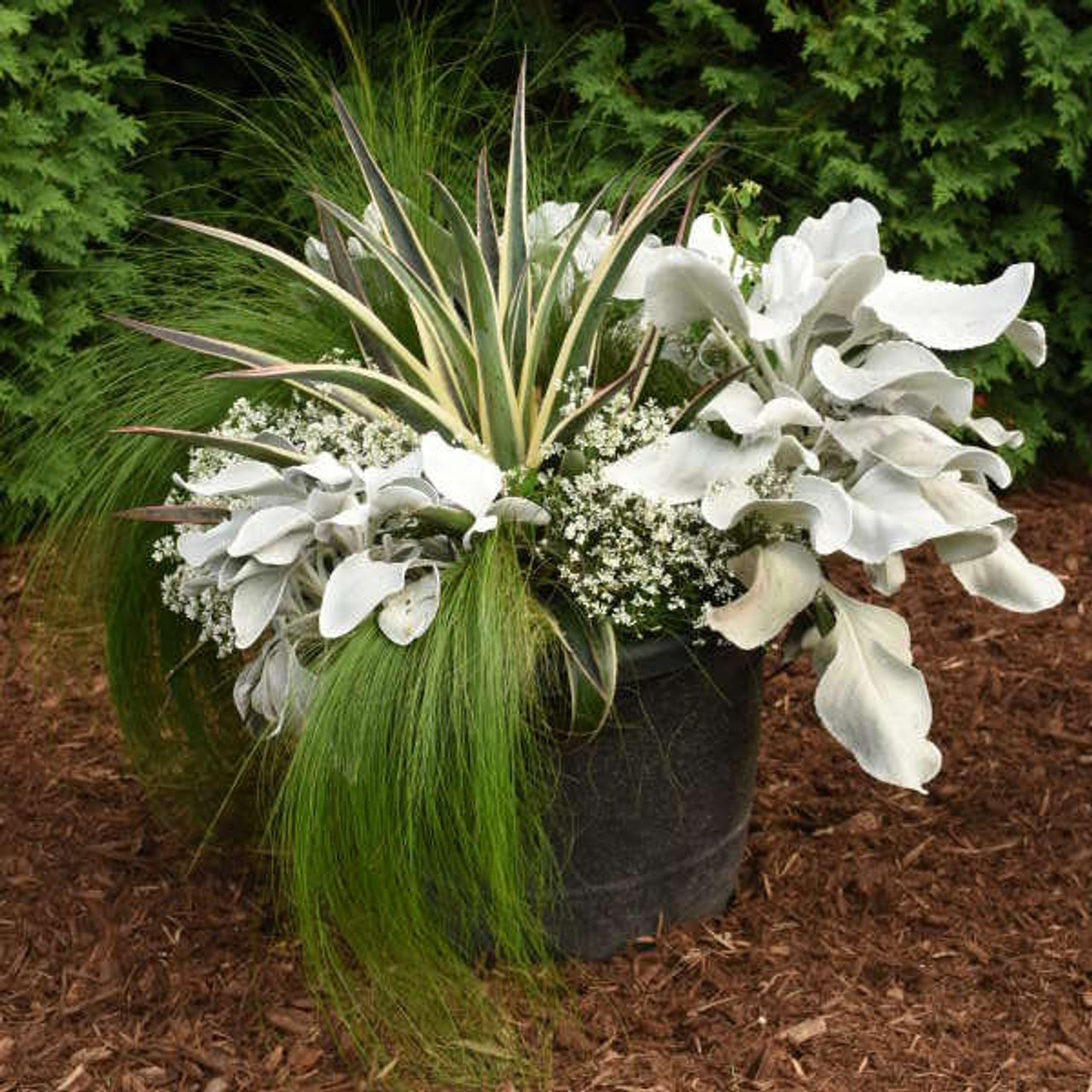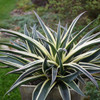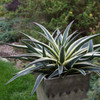Product Description
Mangave 'Snow Leopard' PP31137 - MAD ABOUT MANGAVE Collection (72)ct Flat
Common Name: Mangave
This variegated sport of 'Jaguar' has the long, lance-shaped leaves of the parent but with creamy white margins. Some cherry red spotting exists along the margins, but the bright variegation appears clear from a distance. Compared to 'Kaleidoscope', this has white margins (versus yellow) and dark spots cover the leaves and are pink when on the margin. UV light enhances the spots.
Mangave is a relatively new phenomenon, an intergeneric cross of Manfreda x Agave. These rare hybrids combine the best of both worlds: the better growth rate and the interesting patterns of Manfreda, and the habit and refinement of Agave. We are very excited (shall we say mad?) about our new hybrids from Walters Gardens hybridizing.
Mangave is a tender perennial or "temperennial" succulent plant that grows best in full sun. Plant in well-drained, dry to average soil in containers just slightly wider than the width of the rosette or plant directly in the ground. In summer when the plants are actively growing, they appreciate a bit of supplemental watering and half-strength fertilizer. They should be grown dry in winter. Mangave is a slower grower, so it will not quickly overtake the space it is allotted in the landscape.
Height: 16.0-18.0 Inches
Spread: 22.0-24.0 Inches
Hardiness Zones: 9,10,11
Foliage Color: Green shades, Variegated
Full Sun (> 6 hrs. Direct Sun)
Low Water Needs
Poor to Average Soil Quality
Deer and Rabbit Resistant
Growth Rate: Slow
Container, Drought Tolerant, Attractive Foliage, Small, Specimen, Focal Point, Native to North America
The captivating Mangave 'Snow Leopard' is a hybrid succulent that embodies the best of both worlds, inheriting the striking appearance of Manfreda and the resilient nature of Agave. This unique parentage results in a plant with captivating variegated foliage, a blend of creamy white and green stripes that resemble the markings of a snow leopard. Its long, slender leaves are arranged in a rosette and arch gracefully, giving the plant an elegant form. Some cherry red spotting appears along the margins, but the bright variegation is clear from a distance. This exceptional coloration and form make it a standout addition to any garden or container.
Mangave 'Snow Leopard' is not a species found in nature, but rather a cultivated hybrid. Its parent plants, Agave and Manfreda, originate in the arid and semi-arid regions of North and Central America, particularly Mexico and the southwestern United States. It is a member of the asparagus family (Asparagaceae), which also includes agaves and hostas.
This perennial succulent grows in a symmetrical, low-growing rosette, typically reaching a height of 16 to 18 inches (40 to 45 cm) and spreading about 22 to 24 inches (55 to 60 cm) wide. The foliage of Mangave 'Snow Leopard' is its most distinctive feature. The long, slender leaves are variegated with creamy white and green stripes, creating a striking contrast that intensifies with age and sunlight exposure. Notably, UV light further enhances the spots on the leaves, adding to their visual interest. Its compact size makes it an excellent choice for container gardening, rock gardens, and borders.
Care and Maintenance
Mangave 'Snow Leopard' is a low-maintenance plant that thrives in full sun and well-drained soil. For optimal growth, it needs at least 6 hours of direct sunlight daily. It prefers dry to average moisture levels with very well-drained soil and will often die in standing water. When planting, use a cactus or succulent mix, or amend regular potting soil with sand or perlite to improve drainage.
Water sparingly, allowing the soil to dry completely between waterings. Reduce watering in winter when the plant is dormant. During the growing season (spring and summer), feed with a diluted, balanced fertilizer once a month. In summer, when the plants are actively growing, they appreciate a bit of supplemental watering and half-strength fertilizer. Avoid over-fertilizing, which can lead to leggy growth.
It grows at a fast rate and under ideal conditions can be expected to live for approximately 5 years. However, compared to Agave, Mangave is a slower grower, so it will not quickly overtake the space it is allotted in the landscape. Growers will appreciate the fast growth rate of Mangave—these hybrids finish more quickly than Agave, thanks to their Manfreda parentage.
Mangave 'Snow Leopard' is generally pest-resistant but watch for mealybugs or scale insects. Overwatering can lead to root rot, so ensure proper drainage. Pruning is not necessary, but remove any dead or damaged parts as needed.
Hardiness Zones Mangave 'Snow Leopard' is hardy in USDA zones 9 to 11. It thrives in temperatures between 60-75°F (15-24°C) and prefers warm climates. It should be protected from frost.
Landscape Design with Mangave 'Snow Leopard'
Mangave 'Snow Leopard' can be incorporated into various landscape designs. It can be used as a border plant, in containers, or as part of a rock garden. To enhance the aesthetic appeal of your Mangave and provide a more diverse and thriving garden environment, consider planting it with companion plants. Some suitable companion plants include:
- Stonecrop (Sedum)
- Blue Chalksticks (Senecio)
- Hens and Chicks (Sempervivum)
- Echeveria (Echeveria)
Mangave 'Snow Leopard' can also be effectively used as a 'filler' in the 'spiller-thriller-filler' container combination. This popular container gardening technique involves using three types of plants with different growth habits:
- Spiller: Plants that spill over the edge of the container, such as trailing vines.
- Thriller: Tall, upright plants that create a focal point.
- Filler: Mounding plants that fill in the space between the spiller and thriller.
As a 'filler', Mangave 'Snow Leopard' provides a canvas of foliage against which the 'thriller' plants stand out.
Mangave 'Snow Leopard' is a remarkable hybrid succulent that offers a unique combination of beauty, resilience, and versatility. Its captivating foliage, with its distinctive white and green variegation and red spotting, adds a touch of the exotic to any garden setting. As a low-maintenance plant, it thrives in full sun and well-drained soil, requiring minimal watering and fertilization. Gardeners in USDA hardiness zones 9 to 11 can enjoy this striking plant, whether in containers, rock gardens, or as part of a larger landscape design.
Its drought tolerance makes it an ideal choice for xeriscaping and water-wise gardens. It is also generally resistant to deer and rabbits, reducing the likelihood of damage from these animals. The sap of Mangave 'Snow Leopard' can be irritating to the skin and mucous membranes, so it is advisable to handle the plant with care, wearing gloves to avoid contact with the sap. It is harmful to pets if eaten.
Whether you are an experienced gardener or a beginner, Mangave 'Snow Leopard' is an excellent choice for adding a touch of elegance and intrigue to your outdoor space. Its unique characteristics as a hybrid succulent, combined with its ease of care, make it a rewarding and captivating addition to any garden.
Other Details
The most important part of the plant is its root system. Healthy roots are the foundation of a healthy, vibrant plant. The type of plug container used is based on the specific needs of the plants. Perennials offered as bare root traditionally perform better when planted as bare root.Planted in a specialized mix, potted plants have well established root systems. Top growth stage will vary depending on the current life cycle and time of year when shipped. In Winter and early Spring dormant plants may be shipped. Dormant plants may be planted right away, even before the last frost date.
Most bare root varieties are field grown for at least one season, though Hemerocallis and Hosta are grown for two seasons. The bulk of the soil is removed during the harvesting process and the tops of most varieties are trimmed back to the crown. They are graded, packed in shredded aspen or sphagnum moss and stored in freezers until ready to be shipped.
See our Container Sizes and Bare Root Perennials pages for more information.
Plant information and care is provided in the Overview section, Plant Genus Page and general information is provided in the Planting Care & Guides. Additional questions can be asked on each Plant page.
Plant Spacing: Using the maximum mature spread or width of a plant to guide spacing, ensures space to grow to full size. To fill an area sooner, plant them closer together. Just remember, future thinning or transplanting may be needed.
Water: Keep a close eye on newly planted perennials, especially throughout the first growing year. Most early plant loss is due to too much or too little water!













